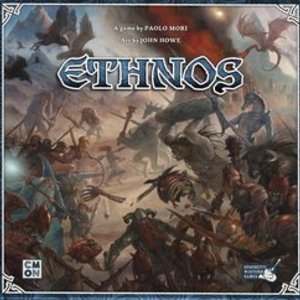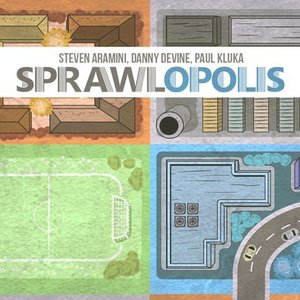
Clash Royale
Entertainment and Games
App
Enter the Arena! From the creators of Clash of Clans comes a real-time multiplayer game starring the...

Mourinho Tactical Board Pro
Sports and Utilities
App
Work your ideas with your technical staff and players Now you can have your data in several devices...

LUNA Capital
Tabletop Game
The dream of maintaining human life on the surface of the moon has now come true. The project to...

Whirling Witchcraft
Tabletop Game
Being a witch is all about wielding powerful magical ingredients — but a witch can wield only so...
Purple Phoenix Games (2266 KP) rated Sprawlopolis in Tabletop Games
Jun 12, 2019
If you had the chance to design a city, how would you do it? Would you have a park on every block for some nice greenery, or do you think a large commercial district will bring in more people? What about housing – would people live right in the heart of the city, or would they live more on the outskirts? The day has finally come where those decisions are up to you! Well, mostly. You’ve been hired to help design the ultimate city! The city officials have given you some specific requirements, but beyond that, the plans are up to you! Can you meet their needs while also maximizing your space? It’s time to put your skills to the test and build the best city ever!
Sprawlopolis is a cooperative card placement game of only 18 cards. Given 3 random scoring conditions, you must draw and play cards into the city to fulfill those requirements. Meet or exceed their score, and you win the game! Fail to do so, and you have not succeeded in building the city up to specifications. Be careful how you decide to place your cards, however, because depending on the scoring conditions in play, certain placements could result in negative points at the end of the game. Working together, you and your team must decide which cards to play at what time to ensure that the requirements are all met. Solo play is identical to cooperative play, except that you just always have a hand of 3 cards from which to play. The score to beat each game is dependent on the scoring conditions, so this game isn’t just another beat-your-own-high-score game – you actually have a specific number in mind.
For a game with only 18 cards, there is a lot of variability in Sprawlopolis. I have yet to play 2 identical games. The layout of each card is unique, as are all of the scoring conditions, so the possibilities are endless… almost! I also enjoy playing this game solo because it requires a decent amount of strategy. Three things factor into your final score (the scoring conditions, block groupings, and roads) and it is impossible to succeed by focusing on only one of them. Your strategy is always changing based on the cards in your hand, and you really have to think about how to best utilize each card for maximum end-game points. Depending on when and where you play a card, it could change the entire city so you have to be thinking about the big picture, literally! And a neat thing about Sprawlopolis is that you can overlap cards. So maybe a card you played earlier is not really ideal anymore, given your current hand, so you can just cover up either a portion of it or the entire card!
The hardest thing about Sprawlopolis for me is that certain combinations of scoring conditions can be difficult to complete. One may give you points for a certain type of city block, but then another may take away as many, or more, points for that same type of city block. Or one gives you points for certain roads, but all roads result in negative points during end-game scoring. Since the scoring conditions are chosen randomly, there’s not really a way to negate this unless you just re-draw those cards. You usually can’t just look at a scoring condition combination and know if it will be difficult or not either – you just have to try it. I’m not saying they’re impossible necessarily, just harder to successfully complete.
Overall, I think Sprawlopolis is a neat game. It’s fast and easy to learn, yet strategic enough to keep you coming back for more games. I like to use it as a nice light filler game between some bigger games, or I just like to play it if I’ve got a quick 15 minutes to spare! Sprawlopolis is a fun game to play with a group, and it’s also a fun game to play solo. In my arsenal of solo games, it’s definitely one on standby.
https://purplephoenixgames.wordpress.com/2019/02/11/solo-chronicles-sprawlopolis/
Purple Phoenix Games (2266 KP) rated Tatorship in Tabletop Games
Feb 18, 2020
Disclaimer: We were provided a copy of this game for the purposes of this preview. This is not the finished product, so some of the components may change in the final printing. -L
Tatorship is a card game of hand management and bidding in which players are racing to complete their secret political missions before their opponents. To set up the game, place the 6 Rights in their respective piles in ascending order. Each player randomly selects a Tator, Top Secret Mission, Bottom Secret Mission, and Executive Mission, as well as Action cards and a Bluff card. The Tator is your character, and provides a unique Executive power. The Mission cards (Top, Bottom, and Executive) each refer to specific Rights in the play area. Action cards provide resources necessary for interacting with the Rights, and for use during the Election.
On your turn, you interact with the current Rights on the table. The Rights in play act as the ‘rules’ for the current round. For example, one Right tells you how many Action cards to draw each turn, and another tells you what your hand limit is at the end of your turn. During this phase, you will also have the opportunity to ‘erode’ (remove) Rights from play. To erode a Right, you must pay the resources displayed on the Right card. Each Right has 4 cards, and the bottom-most card must be showing for that Right to be considered to be completely eroded. Your secret Missions require you to erode specific Rights in play, so you must strategize how to use your resources to best benefit your Missions. After all players have taken a turn, the game moves to the Election phase. During the Election, players are casting votes (the # of resources on the Action card is the # of votes it is worth) in an effort to elect a player to be the Executive for the next round. The Executive goes first in the next round, and gets to assign Roles to all players. In order to complete your Executive mission, you must have the Executive card at time of completion. You can vote for an opponent, as well as yourself. Cast a vote with your Bluff card, however, and your votes do not count! Trick your opponents into thinking you’ve voted for them, but reveal the Bluff and get those votes back. Didn’t win the Election? That’s ok! Take a Backstab card as a condolence. Backstab cards can be played at any time and can negatively affect your opponents, or could give you a leg up over opponents. Play continues until one player has completed all 3 of their secret Missions.
If you are confused at all by the rules/gameplay overview above, I have to admit that I am too. The rules provided with this game are extremely vague and confusing to understand. Not even a rulebook, these rules are compiled on 3 separate playing cards. The text is sparse, ambiguous, and contradictory. For example, one card says that each Right is followed once per turn per player, but in any order. But one of the Rights pertains to the Election phase, which I believe only happens once per round? Or does it happen on every single players’ turn since each Right is supposed to be followed by every player on every turn? The ambiguity of the rules bleeds over into other cards as well. Some cards say to ‘discount’ a Right, but nowhere does it say what ‘discount’ means. Do you immediately erode that Right by one? Or do you just pay one fewer resource to erode? There is no clarification anywhere, and that made this game frustrating to play.
Another qualm with this game is that it is supposed to be educational, but I do not think it achieves its goal. I do have to commend the creators for their efforts, but I think they fall flat. Every Action card has small text at the bottom that details the political concept addressed on the card. Here’s the catch – the text is educational, but it is so small that it can be easily ignored. It also has no bearing whatsoever on the gameplay, so I have to admit that I almost never read any of that extra text.
In theory, this game could be fun and educational. In actuality, though, it falls flat. The ambiguity of the rules meant that we played differently nearly every time. We tried interpreting the rules in several ways, but ultimately we just got frustrated by not knowing how everything actually works. With some serious rules work, this game has the potential to be something good. But in its current state, it feels more like a half-baked potato.
RPGMP3 (211 KP) rated Barker's Row in Tabletop Games
May 25, 2018
Without them, the game is a straightforward card drafting and hand management affair where luck can have a strong effect on who wins in the end. If you have good Attraction cards with useful powers then you can make multiple calls and pull way ahead of everyone else. This is, however, true for a good number of games that involves an element of luck.
I really enjoyed playing this game because of the theme and because some of the cards are fun. The art is excellent and the pieces are good quality. The "Rube" meeples all have different people on them so you can fill your grandstand with all kinds of strange people coming to see your shows.





